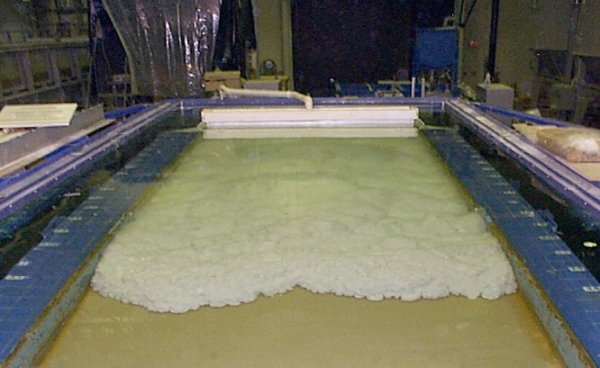MARGINS Tank
Originally built to examine the dynamics of density flows on the continental self, the MARGINS tank measures 24.25-ft long, 9-ft wide, and 7.5-ft deep and has a volume of approximately 12,000 gallons (45,000 l). The tank has a fixed elevation platform at its “upstream” end and two movable plate sections that can be used to set a bottom slope. These plates can be set to provide a constant slope along their entire length or can allow for a break in slope at the junction in the two plates. The tank is equipped with an overflow stand-pipe to maintain a constant water-surface in the tank.
A 4,300 liter mixing tank is capable of supplying saline and/or sediment laden water mixtures to the MARGINS tank.
The MARGINS tank has been used in the past to examine the characteristics of 2-dimensional mudflows1, gully formation by turbidity currents2, and the feasibility of using jets to manage sediments in a combined sewer overflow storage reservoir3, 4.
1 Huang, X. 1999 Two-dimensional transient flows and stability of concentrated suspensions of clay particles and rheology. Ph.D. thesis, University of Illinois.
2 Fedele, JJ, and Garcia, MH. 2009. Laboratory experiments on the formation of subaqueous depositional gullies by turbidity currents. Marine Geology, 258(1-4), 48-59.
3 Sequiros, Octavio, Yarko Niño, and Marcelo García. 2005 January. “Sedimentation Management in Combined Sewer Overflow Storage Reservoirs Using Water Jets.” University of Illinois at Urbana-Champaign. Civil Engineering Studies, Hydraulic Engineering Series No. 76.
4 Sequeiros, OE; Nino, Y; Garcia, MH. 2007 Erosion of finite thickness sediment beds by single and multiple circular jets. Journal of Hydraulic Engineering – ASCE, 133(5), 495-507.
